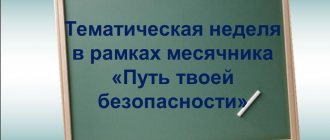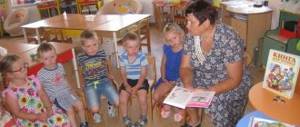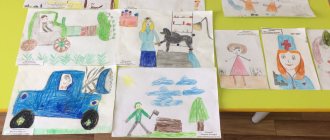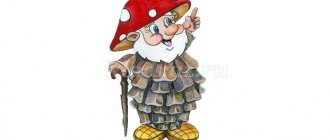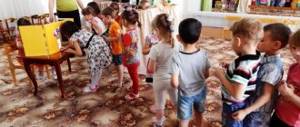Project “We want to be healthy!”
Reading fiction and popular science literature
: V. Berestov “Sick doll”, E. Krylov “How a rooster was treated”, V. Dragunsky “What is good for health, proverbs, riddles, encyclopedia for children “Why”.
Role-playing games
: “Family”, “Grocery Store”, “Hospital”
Modeling from plasticine, drawing, applique (activities and materials of the children’s choice)
“Vegetables and fruits are healthy foods.”
Didactic games
: “The fourth wheel”, “Let’s look in the mirror how neatly we are dressed”, “Daily routine”, “Wonderful bag”, “Who needs what”. “Guess the taste” (5-6 fruits, vegetables)
Excursion
to the kindergarten medical office.
Outdoor games:
“Edible inedible”, “Quickly take it, quickly put it down”;
“Mousetrap”; “Whoever is named is the one who catches”, “Throw the ball into the basket”, “Pass the ball”, “Catch, throw, fall on let’s go” (throwing and catching), “Repeat after me”
Game self-massage
face, ears.
Preventive gymnastics
(respiratory, finger, to improve posture, prevent flat feet).
Health walking
around the territory of the kindergarten (daily for a walk)
Independent activities of children
in development centers
Interaction with parents:
– Announcement of the start of the project
– Consultation for parents within the framework of the project: “Healthy eating - healthy child”, “Finger gymnastics”, “Health is fine - thanks to exercise”, “Do-it-yourself non-standard physical education equipment”
– Making attributes for role-playing games: “Grocery Store”, “Hospital”.
– Production of sports equipment for the sports corner “Krepysh”: dumbbells from waste material, health tracks, games “Serso” from waste material
— Compiling the album “Book about tasty and healthy food. The best recipes for parents"
Practical solution
– Exhibition of children’s works “Vegetables and fruits are healthy products”
–«
A book about tasty and healthy food. The best recipes for parents"
– Making attributes for role-playing games: “Grocery Store”, “Hospital”
– Manufacturing of sports equipment for the physical education corner “Krepysh”
III.
Stage “Final”
Presentation of the project in the form of: an exhibition of children’s works “Vegetables and fruits are healthy products”, “A book about tasty and healthy food. The best recipes from parents”, participation of children and parents in physical education “Health Day”
While implementing this project, I came to the conclusion that the knowledge and ideas the child acquired about himself, his health and physical fitness allowed him to find ways to strengthen and preserve it. The acquired skills helped me consciously choose a healthy lifestyle. Every adult has memories of childhood that fill the soul with incomparable warmth. We want to “take the best things with us” into adulthood, to continue the best family traditions. I hope that the chosen path - a healthy lifestyle - will become the best family tradition that the children will take into adulthood. After all, each of us wants to see our children healthy, happy, so that children, growing up, live in harmony with themselves, the world around them, and other people. And behind all this is a healthy lifestyle. It is he who gives physical and spiritual strength, a healthy nervous system, the ability to resist harmful influences, and feel the joy of being alive.
Project in the senior group on the topic: Healthy lifestyle in kindergarten
Project on the topic: “An exciting journey into the world of a healthy and safe lifestyle”
Author: Olga Viktorovna Isaeva, teacher at the Municipal Preschool Educational Institution “Kindergarten for Care and Health No. 190” in Saratov Description: The project is intended for children of the older group. This project will be useful to teachers of preschool educational institutions. The project reflects the use of health-saving technologies in the educational process. Passport 1. Type of project: practice-oriented 2. Duration: average duration from 1.09.2013-31.05.2014 3. By number of participants: group. Relevance of the problem Preschool age is an important period when human personality is formed. It is very difficult to determine whether a person behaves correctly or incorrectly in certain circumstances. However, it is necessary to highlight rules of behavior that children must strictly follow, since their health and safety depend on this. These rules should be explained to children in detail and then monitored for their implementation. However, safety and a healthy lifestyle are not just the sum of acquired knowledge, but a lifestyle, adequate behavior in various situations. Therefore, the main task is to stimulate the development of independence and responsibility in children. After all, everything that children are taught, they must be able to apply in real life, in practice. The goal of the project is to introduce children to a healthy lifestyle, strengthen physical and mental health, and develop the ability to independently behave safely in everyday life based on the rules of safe behavior. Project objectives To form ideas about the value of health. To promote the formation of a sustainable interest in the rules and norms of a healthy lifestyle. To develop knowledge about preventive and health measures. Develop the ability to avoid situations hazardous to health. To form children’s ideas about the main sources and types of danger in everyday life, on the street, in nature and methods of safe behavior. Hypothesis It is advisable to promote the formation of a culture of a safe lifestyle precisely in preschool age, when such age-related and psychophysiological characteristics as extreme curiosity and emotionality, ignorance and misunderstanding of the dangers that await a person can lead to dire consequences. Problematic issues • Fostering the need for a healthy lifestyle. • Mastering skills to prevent and overcome potentially dangerous situations, developing readiness to use this experience in constantly changing conditions. Methods and techniques • Reading works of fiction • Conversations, watching videos. • Didactic, role-playing, outdoor games. • Problem situations, modeling. • Celebrations, entertainment, quizzes.. • Research activities. Material used in work • Attributes for games. • Fiction and scientific literature. • Posters • Didactic material. Expected result • The child has an idea of his health and knows how to maintain and strengthen it. • The child is motivated to preserve his health and the health of others. • Increasing the body's resistance to diseases.. • Increasing the competence of parents in matters of child safety. • Orienting parents to jointly with the teacher introduce children to a healthy lifestyle • The child is able to solve some problems of a healthy lifestyle and safe behavior. Project stages Responsible for the project: educators.
Download Project for the senior group on the topic: Healthy lifestyle in kindergarten
We recommend watching:
Formation of a healthy lifestyle in preschool children through valeology Conversation with game elements, for children of the senior group on the topic: Healthy lifestyle Health-saving technologies in the development of preschool children through outdoor games Conversation for children of the preparatory group. Tuberculosis Day
Similar articles:
Proverbs and sayings for preschool children about health
Word games on a sports theme for older preschoolers
Conversation “Good and bad habits” in the senior group
Project for senior preschool children “Be Healthy”
1 part. Relevance of the project:
The health of children is one of the most important and global problems of our society, including our preschool educational institution. The tasks of preserving and strengthening the physical and mental health of children, improving their physical development are the basis of the Children's Health Program in preschool educational institutions. According to statistics, the 21st century began in Russia with a sharp deterioration in such a significant indicator as the health of preschool children. The number of healthy children decreased by 8.1%, and the number of children with impairments in physical development and a predisposition to pathologies increased by 6.7%. The number of children in the third health group with clearly defined disabilities and chronic diseases increased by almost 1.5%.
Part 2. Definition of the subject of research:
“Take care of your health from a young age,” says a popular proverb. Formation of skills and habits of a healthy lifestyle in preschoolers is relevant and significant in modern conditions. We encounter this problem every year in preschool institutions: children’s poor health, low level of physical development, etc. The main idea of work to develop skills and habits of a healthy lifestyle in preschoolers is that in order to achieve harmony with nature, with oneself and society, a person needs to take care of his health from childhood. After all, health is considered as a harmonious state of the body (physical, mental, social - well-being), which allows a person to be active in his life. It should be noted that developing habits and skills for a healthy lifestyle in children is impossible without interaction with the families of the students.
Part 3. Problem formulation.
The problem of deteriorating health of the younger generation has become increasingly relevant in recent years. According to the Ministry of Health of the Russian Federation, only 13% of children aged 5-7 years can be considered healthy. Preserving and strengthening health, developing a conscious need for a healthy lifestyle should be given as much attention as possible in preschool age. And success in improving the health and full physical development of children, in increasing their physical activity is possible only with unified approaches to physical education in kindergarten and at home. Unfortunately, in practice it is observed that children experience “motor deficits”, are overweight, and have poor posture. Analysis of the survey shows that in many families the need for movement of preschoolers is far from being fully satisfied; preference is given to watching TV shows, computer games, static activities and sedentary games. The heavy workload of parents leads to a reduction in walks in the fresh air, thereby the child’s natural need for movement in the family, albeit unconsciously, is suppressed. The main reasons for these results are that parents underestimate the role of motor activity, which ensures the healthy functioning of the child, do not take a conscious enough approach to the process of physical education of children, underestimating their role in this process and shifting the main burden to the educational institution. And as a result, they do not understand the importance of all the criteria that contribute to the formation of a healthy lifestyle in children.
Part 4 Proposing a hypothesis.
It is known that health, more than half, depends on lifestyle, a quarter on the environment, and much less it is connected with heredity and the state of health care in the state. To ensure health, many things are important: a healthy lifestyle, proper, nutritious nutrition, medical and preventive work, hardening, and maintaining a hygiene regime. Due to the particular relevance of the problem in the process of pedagogical activity, the question of a creative search for approaches to strengthening the health of children and the implementation of effective forms of interaction between preschool educational institutions and families to formulate the need for pupils for a healthy lifestyle has arisen. The search for innovation led to a solution to the problem through the design method. Pedagogical (creative) project “Be healthy!” served as the basis for targeted pedagogical experimentation.
Part 5 Hypothesis testing.
The parental family is the most important institution for developing a healthy lifestyle. It is impossible to move to new forms of relations between parents and teachers within the framework of a closed kindergarten: it must become an open system. “Openness of the kindergarten inward” is the involvement of parents in the educational process of the kindergarten. The active use by teachers of various, especially non-traditional, forms of work with parents will allow them to successfully solve the problems of creating a healthy lifestyle and will help reduce diseases.
The goal of the project: to form initial ideas about a healthy lifestyle, expand knowledge about maintaining health, and increase the desire of parents to use physical activity with children to form the foundations of a healthy lifestyle. Project objectives: 1. Expand ideas about health and its values 2. Strengthen and preserve the health of children by introducing physical education, health, hardening activities 3. Cultivate the habit of a healthy lifestyle 4. Give parents an idea of the importance of joint physical activity with children. 5. Expand parents’ knowledge about children’s physical abilities and skills. 6. Contribute to the creation of an active position of parents in joint motor activities with children 7. Establish cooperation with the families of pupils on the problem of strengthening the physical and mental health of children.
Project type: Duration: short-term Area of activity: cognitive - speech, informational, practice-oriented with elements of activities aimed at improving health.
Project participants: children of the senior group “Fidgets” (5-6 years old), teacher, parents
Duration: 1 week (short-term)
Expected result: -organization of a meaningful health-saving developmental environment in the group; -reducing morbidity and increasing the level of health of children; - the formation of a hygienic culture in children and the presence of a need for a healthy lifestyle; - active assistance and interest of parents in organizing work to improve the health of children
Project implementation stages
I. Preparatory stage Creating the necessary conditions for the implementation of the project: - setting goals and objectives - creating conditions for the implementation of the project - selecting educational and fiction literature - conducting conversations - preparing attributes for games and activities
II. Main (practical stage) - implementation of the main activities of the project
Monday
Conversation: Conversation “How to maintain health in the spring” Looking at photo albums, photographs, postcards about the rules of behavior on the street, about spring clothes Reading proverbs and sayings about health D/I: “Strong kids”, “Who will reap the harvest faster” GCD. Cognition Topic: “Eyes are the main assistants of a person”
Tuesday
Conversation: “I love vitamins - I want to be healthy” GCD. Modeling “Healthy and unhealthy products” Role-playing game: “The family buys healthy products” Viewing the presentation “Vitamins and microelements” Learning poetry: “Where do vitamins live?” S. Loseva D/I: “Wonderful bag”, “Cooks”, “Where porridge grows” Consultation for parents “How to raise a healthy baby”
Wednesday
Conversation: “Conversation about health, cleanliness”, solving provocative questions, problematic situations Morning exercises NOD. Drawing “Moidodyr” Watching the animated film “Micropolis” Reading the fairy tale by G. Nemkina, M. Savka “The Story of the Fairy Vitaminka” UNICEF, 2009 Role-playing game “Sports base “Valley of Health”
Thursday
Conversation: “Sport is the key to health” Role-playing game: “Fitness club” Viewing the presentation “Secrets of Health” Learning poetry: “Athletics” V. Pakhomov Viewing the presentation: “Brushing our teeth correctly” P/N: “Do as I do” , “The Power of the Ball” Consultation for parents: “It’s good to be healthy”
Friday
Listening to audio recordings: songs about sports, about health Watching the presentation: “Rationales” (children about health, about proper nutrition) D/I: “Sports games”, “Healthy - harmful”, “Sports guessing game” Exhibition of drawings: “Sports” , sport, sport" (see Appendix No. 18) Photo report on work in the group and with parents
III. The final stage
summing up the results of the project - organizing the exhibition “Sport, Sports, Sports” - preparing a photo report on the work done - preparing a clip for parents about a healthy lifestyle
Part 6 Project results
The “Be Healthy” project lasted one week. While working on the project, the children set themselves the following goals and objectives: What we know: - A healthy person is not only one who strengthens his body through physical exercise, but he also monitors his health. - To be healthy, you need to eat well. — Food can be tasty and not tasty. — To strengthen and maintain health, you need to play sports, exercise, harden yourself, follow a routine, and walk in the fresh air. “If you don’t follow the rules of hygiene, you can get sick.” — Harmful microbes kill health, and “good” ones help not to get sick. What we want to know: - Why don’t we get sick all the time? — How can you protect yourself from diseases? — What benefits do healthy foods bring to the human body? — Why do you need to support beneficial microbes? -What food is the healthiest? — What do you need to feel healthy? How we will find out: - we will ask our parents; - look in encyclopedias, books, magazines, on the Internet; - watch videos, presentations, cartoons - ask the doctor, friends, acquaintances; — we’ll go with our parents to a pharmacy, clinic, store; - go on an excursion to the medical office, food department Resources: - looking at photo albums, illustrations, story pictures depicting healthy and unhealthy foods, sports - reading works of art: fairy tales, short stories, poems, sayings, riddles about sports, healthy and bad habits, about food - conversations on project topics - listening and singing songs on the project topic - watching presentations on the project topic - watching cartoons about microbes Materials: - photo albums, encyclopedias, books (children brought from home) - fiction - iso-materials for creativity children, building material - audio recording of children's songs - video recording of a cartoon - attributes for board games, didactic, role-playing and dramatization games - table theater Labor: - selection of information and design of materials on the topic of the project - appliqué, modeling, drawing Game: - Didactic games – Outdoor games – Role-playing games
References:
1. T. S. Nikanorova, E. M. Sergienko “Healthy” health improvement system for preschool children 2007 2. E.I. Podolskaya “Forms of health improvement for children 4-7 years old” 2009 3. S.E. Shukshina “Me and my body” 2004 4. E.A. Babenkova, O.M. Fedorovskaya “Games that heal” 2008 5. T.A. Shorygina “Conversations about health” 2010 6. Vakhrushev A.A. Kochemasova E.E. “Hello, world! The world around us for preschoolers,” 2003. 7. Jackie Silberg “500 five-minute educational games for children aged 3-6 years” 8. Alyabyeva E.A. “Games for children 4-7 years old” Moscow, 2009. 9. Materials from the Internet
The result of work on the project is not the amount of information acquired by children about health promotion, but the child’s ability to implement a healthy style of behavior. The culture of a healthy style of behavior is understood as the general ability and readiness of the child’s personality for activities to protect and promote health, based on the knowledge and experience acquired in the educational process of the preschool educational institution and the family. Therefore, the goal of working on the project was to increase the effectiveness of health-oriented activities in preschool educational institutions through the creation, theory and practice and practical formation of healthy lifestyle values among preschoolers, taking into account their age and individual capabilities. At the kindergarten, all conditions have been created for the full physical development and improvement of children. To develop physical qualities, form motor abilities and skills, and foster the need for independent physical exercise in the group, a physical education corner is equipped: it has all the necessary physical education equipment for children’s independent motor activity, attributes for outdoor games, physical education equipment for gymnastics after sleep, equipment for individual preventive work with children. The “health corner” has accumulated a wealth of material: didactic games and manuals on the culture of behavior, maintaining a healthy lifestyle, observing the rules of safe behavior and rules of personal hygiene. Learning occurs through all types of activities of the child during his stay in a preschool institution. Forms of educational organization: classes (health lessons), games, game situations, conversations, theatrical performances, reading fiction, drawing. Great importance is given to organizing a good daytime sleep. A method used to put children to sleep is listening to fairy tales. After daytime rest, post-sleep gymnastics are performed in combination with preventive procedures and massage. Evening time is intended to relieve fatigue. Therefore, more relaxation activities are included: minutes of pranks, joy, minutes of music and fairytale therapy. A healthy lifestyle is unthinkable without a rational, varied diet. Nutrition, as is known, is one of the factors that ensures the normal development of a child and a sufficiently high level of resistance of his body to diseases. In our preschool institution, the following principles of rational healthy nutrition for children are followed: regularity, nutrition, variety, by observing the diet, food consumption standards and an individual approach to children during meals. One of the mandatory conditions for developing a culture of child health is a culture of family health. When working with families to develop the need for a healthy lifestyle in children, both traditional and non-traditional forms of working with parents are used, such as information stands, thematic exhibitions, health information corners are set up, consultations are held, family sports relay races, and multimedia presentations. Parents are regular participants in all competitions held at the preschool educational institution.
Author: Litvinenko Olga Nikolaevna, teacher of the first category, MADOU d/s No. 38, Tomsk, Tomsk region, Russia
The article is published in the author's edition
